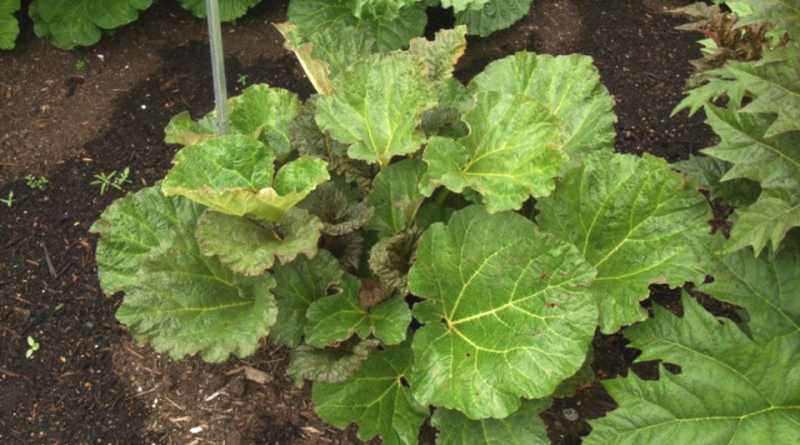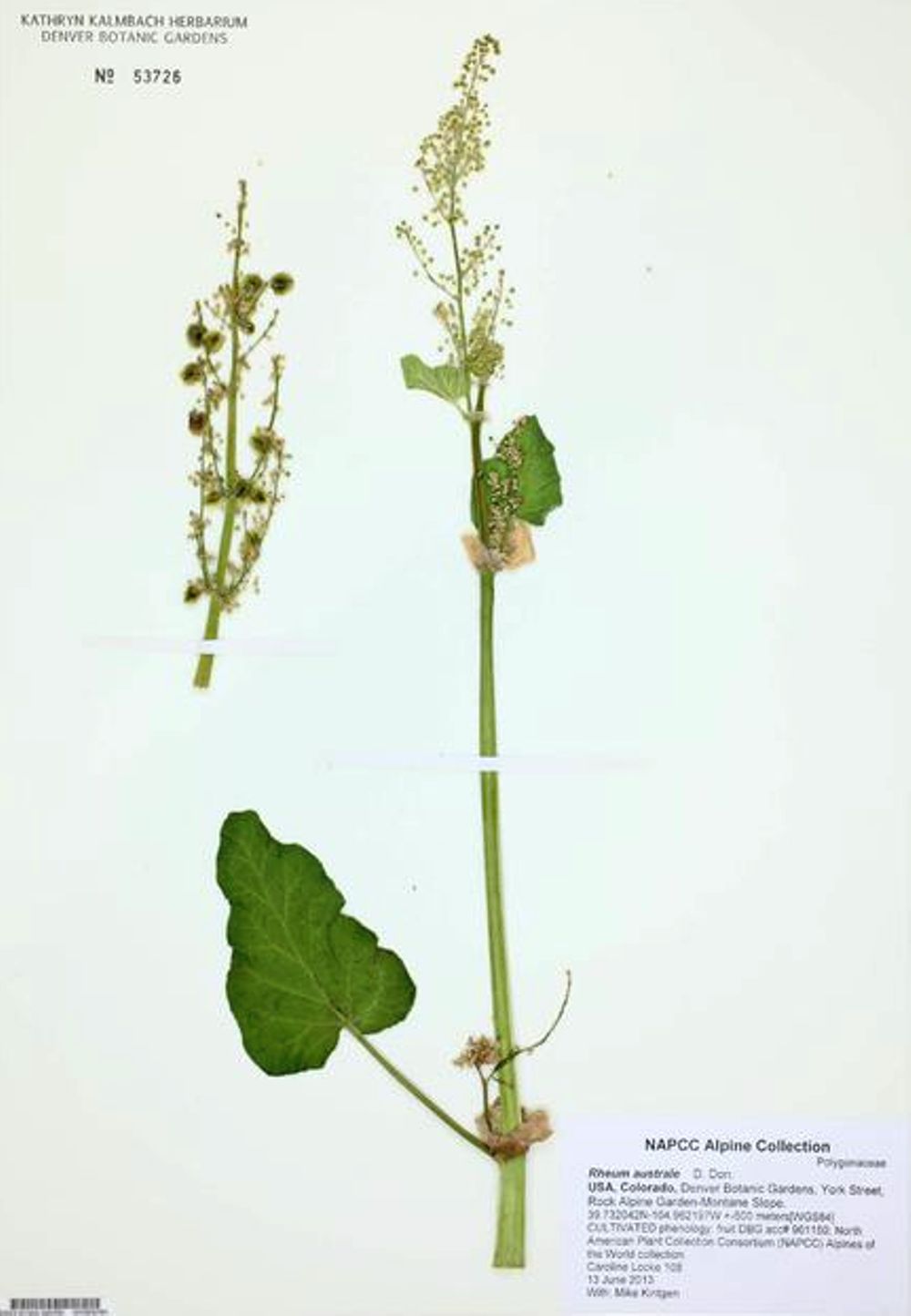Rheum australe
Rheum australe
Himalayan rhubarb or Indian rhubarb (Rheum australe D. Don) is a herbaceous species belonging to the Polygonaceae family.
Systematics –
From a systematic point of view it belongs to:
Eukaryota Domain,
Kingdom Plantae,
Subarign Tracheobionta,
Magnoliophyta Division,
Magnoliopsida class,
Subclass Caryophyllidae,
Polygonales Order,
Polygonaceae family
Genus Rheum,
R. australale species.
The following terms are synonymous:
– Rheum emodi Wall.;
– Rheum emodi Wall. ex Meisn.;
– Rheum emodium Wall.;
– Rheum emodium Wall. ex Nees & Eberm..
Etymology –
The term Rheum comes from the root rheu; par excellence al rheu barbarum root of the barbarians, from which rhubarb.
The specific southern epithet comes from the Austro auster, the south wind: an entity originating from the southern portion of the geographical area in which it was initially found.
Geographic Distribution and Habitat –
Rheum australe is a native and widespread species in the temperate Himalayan area, from Kashmir to Sikkim and present in India, Myanmar, Nepal, Pakistan, Bhutan and Sikkim.
Its habitat is that of the alpine areas, on rocky soil, morainic and crevasses, among boulders and near streams in special pockets. Its altimetric diffusion is between 2800 and 4000 m. s.l.m ..
Description –
Himalayan rhubarb is a herbaceous plant with a 1.5-2 m high stem.
The stem is robust, reddish in color and streaked with green and brown.
The leaves are large, heart-shaped or rounded with a heart-shaped base and are greenish red. The basal leaves can be up to 60 cm wide.
The flowers are dark purple red or yellow, present in densely branched clusters, in an inflorescence up to 30 cm long. The inflorescence widens a lot when the plant bears fruit.
The antesis is from late spring to summer.
The fruit is a trigone walnut with prolonged edges in a membranous wing.
Cultivation –
Rheum australe is a plant that is grown sporadically in the areas of origin for its leaves, which are used as a vegetable.
The plant needs temperate climates of the subalpine and alpine areas of the Himalayas.
The soil must be well-drained, porous and rich in humus. The plant prefers exposed or semi-shaded environments and can be grown at altitudes above 1800 m in height.
For the propagation it is possible to proceed by sowing or through the upper segments of the rhizome.
The seeds are collected in the period of September-October; they have a high and rapid germination rate and do not require specific pre-treatments.
The seedlings are obtained from nurseries prepared in March in open places or in February in sheltered places.
The plant has a three to five year juvenile stage, followed by a reproductive stage.
The seeds are harvested between the end of August and September, when they turn dark brown.
The seed production potential ranges from 300 seeds to 950 seeds per plant.
For propagation, the seeds are sown in rows 15 cm apart.
In temperate conditions, the seeds are sown in the spring season (March-early April). Seed germination is complete within one month of sowing.
On average, about 600 g of seeds are needed to raise a nursery for planting one hectare with seedlings placed at a distance of 50 cm × 50 cm.
No specific pre-treatment is required for seeds.
Customs and Traditions –
Rheum australe is a medicinal herb used in the Unani Indian medical system and formerly in the European medical system where it was traded as Indian rhubarb.
This plant is first mentioned in the Chinese herbal medicine Pen-King, which listed it as a purgative and stomachic.
It found its way to the West via Turkey and Russia, and was first planted in England by a pharmacist named Hayward in 1777. It soon found its way into the kitchen, where its tart flavor became popular in desserts such as rhubarb crumble, as well as in jams, jellies and sauces. Rhubarb is a vegetable but is often considered a fruit.
According to the 2003 Flora of China key, this species is distinguished from other whole-leaf rhubarb by its wavy or crunchy edge.
The plant is used for various therapeutic purposes: it is a mild purgative, astringent, tonic, laxative, stomachic and aperient. Powdered rhizomes are sprinkled on ulcers for quick healing.
It is also said to be a powerful anti-inflammatory drug.
Rheum australe contains some active ingredients including: hydroxyanthracene derivatives which are mainly emodin, chrysophanol and their glycosides. Other hydroxyanthracene derivatives are rhein, aloe emodin and parietin and their glycosides.
Preparation Method –
Rheum australe is a medicinal plant of immense importance with a diverse pharmacological spectrum. In addition to having the aforementioned pharmacological properties, it has been used as an ingredient in many herbal formulations, which are used for the treatment of various diseases, in particular the regulation of blood fats, hepatitis and cancer. The plant could be further exploited to isolate the various biologically active constituents responsible for its activity.
The stem of this rhubarb can be cooked or eaten raw; some people soak the raw stems in sugar to remove some of the acidity. It should be noted that generally only the stem of the plant is eaten, as its leaves contain potassium oxalate which can sometimes cause poisoning, occasionally fatal in people with susceptibility to oxalic acids.
Guido Bissanti
Sources
– Acta Plantarum – Flora of the Italian Regions.
– Wikipedia, the free encyclopedia.
– Useful Tropical Plants Database.
– Conti F., Abbate G., Alessandrini A., Blasi C. (ed.), 2005. An annotated checklist of the Italian vascular flora, Palombi Editore.
– Pignatti S., 1982. Flora of Italy, Edagricole, Bologna.
– Treben M., 2000. Health from the Lord’s Pharmacy, Advice and experiences with medicinal herbs, Ennsthaler Editore.
Photo source:
– https://www.gbif.org/occurrence/gallery?taxon_key=4038150
Warning: Pharmaceutical applications and alimurgical uses are indicated for informational purposes only, they do not represent in any way a medical prescription; therefore no responsibility is taken for their use for curative, aesthetic or food purposes.


